- Offensive Techniques & Strategies
Disrupting "Off Ball" Screens

Teamwork and communication are vital in disrupting off ball screens. In fact, if you watch closely during a game or analyze videotape, you will see that most players get screened by their own teammates. In attacking the passing lanes, deflections and steals that that lead to easy transition baskets are the ultimate goal. However, by forcing the receivers coming off screens away from the basket and out of their normal operating paths, it provides the added benefits of disrupting offensive spacing and flow creating longer shots, longer drives to the basket, and longer post feeds.
| Preventing | Switching | Beating Out | Pulling Through | Screen Types | In Review |
Four Techniques To Use To Successfully Combat Screens Away From the Ball
There are three components to an off ball screen: the passer, the screener, and the receiver. Defenders must 'talk' and coordinate their efforts in attacking these three players. Helpside defense also plays a role in defending screens.
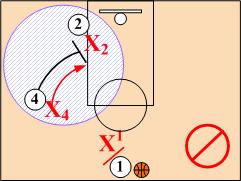

 Prevention Option - "Disrupt the Screen"
Prevention Option - "Disrupt the Screen"
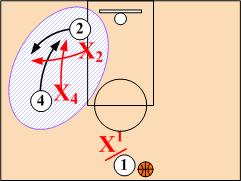
Jam the Screener
Prevent or disrupt the screen, by maintaining a strong elbow high, shoulder to shoulder, pass denial position forcing the screener into the path of the receiver. This will force the receiver to take the long way around the screener and allows the defender to just cut over the screen.
Influence the Receiver Opposite the Screener
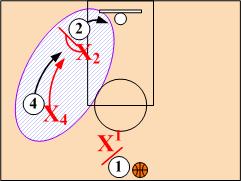
Screens can be disrupted by blocking and forcing the receiver away from the screen.


 Jump Switch - Attack the Passing Lanes
Jump Switch - Attack the Passing LanesIn screening situations, jump switching is the most effective way to disrupt screens and deny passing lanes. Automatically switching on contact eliminates any hesitation or indecision on the part of the defenders. It not only totally disrupts any type of screening offensive flow, but also results in fewer fouls being committed.
"Switch to Steal"
Successful jump switching requires a team effort:
The player guarding the screener must alert teammates of coming screen, and then step out and aggressively block the shooter's path coming off the screen.
The player being screened must take away the roll option by "Stepping Over" the screener into a strong pass denial position.
The player guarding the ball handler must pressure and force the passer into dribbling by taking away the shot and pass options.
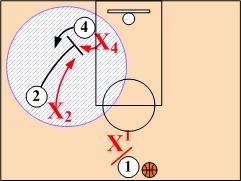
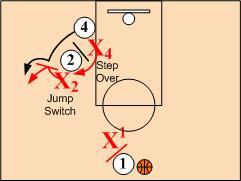
When offensive player O2 sets a down screen for O4, defenders X2 and X4 execute an aggressive jump switch. Defender X2 jumps out blocking the receiver O4's path to the ball assuming a strong pass denial position. Defender X4 takes away the screen and roll option by stepping around the screener O2 and assuming a strong pass denial position. X1 pressures ball handler O1.

Anticipate a down screen when a big player starts out high and "Invert" prior to the screen whenever possible.

 Beating the Receiver Out - "V-Step" Option
Beating the Receiver Out - "V-Step" OptionIn situations where very big players set screens for smaller players and inverting is not possible, chasing out becomes a viable alternative to jump switching. However, to be success in this situation, the defender cannot just trail the receiver out. Beating the receiver out can be very effective in stopping a great shooter with a quick release.
Beating the Receiver Around the Screen
To get around the screen, the defender must first move to the outside shoulder of their opponent and then execute a "V-Step" over the screen by diving into a strong pass denial position. The screener's defender must "Show"(step out temporarily with a hand extend in the passing lane) to force the receiver wide and then recover back to the screener.
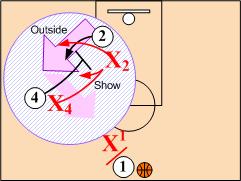
Phase 1. Defender X2 goes out under O4's screen moving to the outside shoulder of O2 to get around the screen. Moving to the outside shoulder also provides the defender with more room and a better angle to dive and cut off the receiver. Defender X4 steps out and shows in the passing lane.
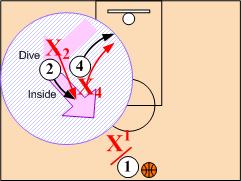
Phase 2. After reaching the screen, X2 completes the V-step by diving back to the inside of O2 and assuming a strong pass denial position. Defender X4 helps out by stepping out ("Shows") into the passing lane on screen. Defender X1 pressures ball handler O1 with active hands.

 "Shadow" - Sag Off the Screener & Zone
"Shadow" - Sag Off the Screener & Zone When the screener is not an offensive threat, the screener's defender can sag off (zone) in a 'Shadow' support position allowing the receiver's defender to cheat through the screen. The "Shadow" can assist by "Pulling" the defender through the screen.
"Pull Thru" the Screen
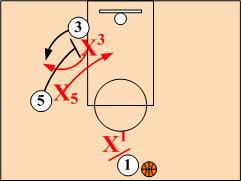
When the screener is not an offensive threat, the defender can sag off (zone) in a 'Shadow' support position allowing the receiver's defender to cheat over the screen. The "Shadow" can assist by "Pulling" the defender through the screen.

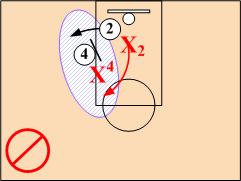
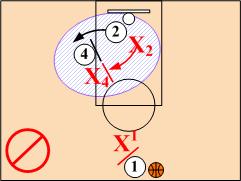
In this case, the defender looses all contact with the receiver. In addition, when this happens the defender guarding the screener forms a double screen.

Types of 'Off Ball' Screens to Defend


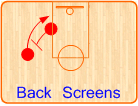

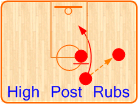

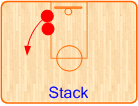
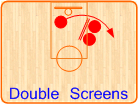
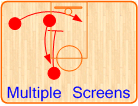
Click on Off-Ball Screen Image Above To View Disruption Details.

In Review
Defending screens require communication, teamwork, and enthusiasm.
In order to attack or disrupt screens, they must be first analyzed as to how and why they are being set.
Types of “Off Ball” screens to defend include Down Screens (Pin Downs), Diagonal Screens, Base Screens, Back Screens, High Post Rubs & Shuffle Cuts, and Double Screens.
Aggressively jump switching is the most effective way to disrupt screens and deny passing lanes.
When big players start out high, if at all possible, "Invert" (switch opponents early) prior to the screen in order to keep big players inside.
In situations where very big players set screens for smaller players and inverting is not possible, beating out using a V-Step becomes a viable alternative to jump switching.
The High/Low Switch technique is the most effective way to disrupt base screens.
On back screens, an automatic contact switch must take place.
When the opponents form a double screen alignment, a verbal call should be yelled out such as “Double - Double” to trigger and coordinate the defensive (Drop Off, Step Out and V-Step) actions.
During a game, players must know what type of screens to expect and how to combat them.
Return to Player Development - Click Here
Return to Defensive Strategies - Click Here
Return to HoopTactics - Click Here
© 2026 HoopTactics All Rights Reserved.
